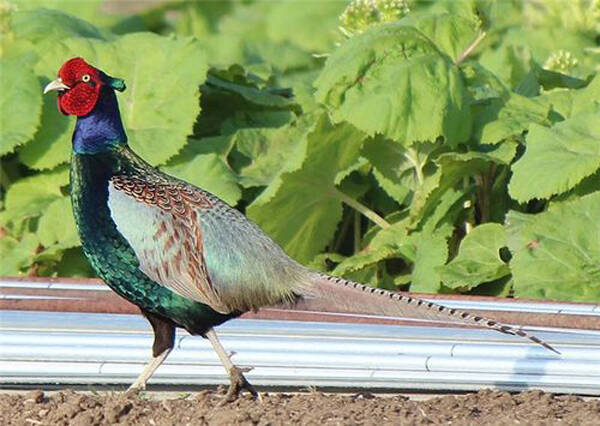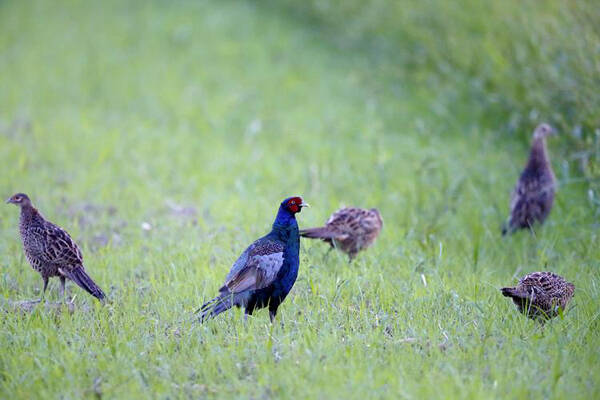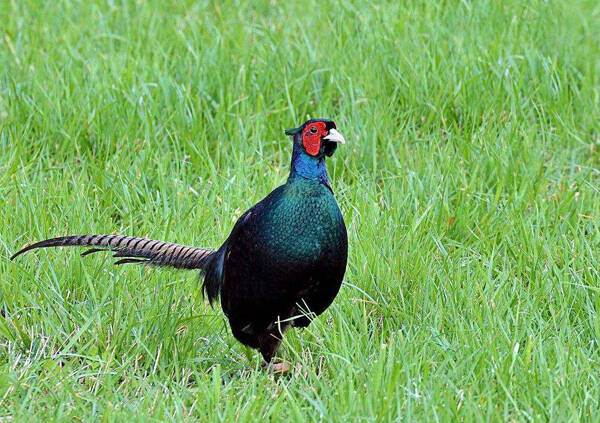Phasianus versicolor
IUCN
LCBasic Information
Scientific classification
- name:Phasianus versicolor
- Scientific Name:Phasianus versicolor,Green Pheasant
- Outline:Landfowl
- Family:Galliniformes P.family P.Genus
Vital signs
- length:About 80 cm
- Weight:700-1400g
- lifetime:No textual research information is available
Feature
It is the national bird of Japan
Distribution and Habitat
It is distributed in Japan, including Kyushu, Honshu, Shikoku, Miura Peninsula, Izu Islands, Yakushima Island, Sado Island, and the coast of the inland Sea.
It lives in shrubs, meadows and bare rocks from sea level to 1,000 m above sea level, mostly in lowlands and swamps in Japan.
Appearance
The green pheasant is a large chicken. It is about 80 cm long. The male bird has a tuft of bronze to bronze crests on its head. The upper body feathers are mostly copper, blue-green and other colors, with metallic luster; White underback and waist. Flight feathers black brown with green margin, tail feathers blue-green. The lower body is black, the corners of the mouth are gray, and the feet are yellow-gray. The female has dark brown feathers, white back, and brown stripes on the flight and tail feathers. The size and color difference between male and female is obvious, the male pheasant face is red, the strength, chest and abdomen are dark green, and the tail is long, with many black banded feathers. The female is pale brown with black markings and a short tail.
Details
The Green Pheasant (Phasianus versicolor) is a species endemic to Japan, and its species name "versicolor" means "color-changing" or "color-diverse". The Green pheasant was once listed as a subspecies of pheasant (Phasianus colchicus versicolor) by ornithologists, and was officially recognized as a separate species by BirdLife International in 2014. It is found only in Japan and was designated as the national bird of Japan in 1947.

Green pheasant strong feet, good at running, especially in the bush to run very fast, fast and powerful flight, but the flight distance is not big. And good at hiding. After seeing people, they usually run quickly on the ground, and soon enter the nearby jungle or brush, sometimes running for a while and stopping to look at it before walking. It takes off only when it has to, making a "cluck" sound and two wings "flutter..." The sound of agitation. The flight speed is fast and very powerful, but the general flight is not durable, the flight distance is not large, often a parabolic flight, gliding before landing. After landing, they quickly ran and hid in the bushes and bushes, easily stopped taking off, and sometimes people went to the front of their eyes and suddenly flew up. In autumn, small groups of a few to more than 10 animals are often integrated into farmlands, forest margins and near villages for activities and foraging.
The green pheasant is an omnivore. The food eaten varies by region and season: In autumn, it mainly feeds on the fruits, seeds, plant leaves, buds, grass seeds and some insects of various plants; in winter, it mainly feeds on the buds, shoots, stems, fruits, seeds and grains of various plants; in summer, it mainly feeds on various insects and other small invertebrates as well as the buds, berries and grass seeds of some plants; in spring, it pecks at the young grass stems and grass leaves that have just sprouted. They often go to the farmland to eat the seeds and seedlings planted. They also eat insects and small invertebrates.

In the wild, the green pheasant has a multi-female mating system, with a male bird mating with 4-8 females. Every year between March and May, the green pheasant begins to enter the breeding period, the male bird "clucking" hooves, the sound is clear and loud, can be heard in the distance, at this time, the male bird frequently flaps its wings, a light dance to woo the female bird. In this period, female birds will choose to build simple nests with grass stems, branches and leaves in the wild grass and mountain forests that are rarely visited. The size of the nests is 23×21 cm and the depth is 6-10 cm. Females lay 6-12 eggs at a time, with oval eggs ranging in size from 37.0-46.2×31.0-36.0 mm and egg weight from 19.0-28.5 grams. However, there are certain differences between different regions and different subspecies, the shell is grayish brown or light turquoise, shiny, with some light brown or purple brown spots, and the incubation period is 23 to 25 days.
The origin of green pheasant is limited to Japan, there are many moving stories about it in the Japanese folk spread, Japan formulated the national bird in 1947, at that time, the idea of bird protection in Japan was not popular, and wild birds were caught everywhere. In order to change this habit, Dr. Oliver L. Austin, appointed by the commander of the Allied Forces stationed in Japan, urged the Ministry of Agriculture and Forestry to enact stricter hunting laws, and the Ministry of Education to strengthen bird-loving education. That's when Bird Love Day (April 10) began, and later evolved into Bird Love Week (mid-May).

At that time, the Japanese Ministry of Education decided to choose the national bird in order to promote bird protection. On March 22, 1947, the Japanese Ornithological Society held its 81st general meeting, attended by 22 ornithologists. It was at that meeting that the green pheasant was voted for (other proposed species included pigeons, larks, tree warblers, and copper pheasants).
Listed on the IUCN Red List of Threatened Species (IUCN)2016 ver3.1 - Not Threatened (LC).
Protect wild animals and eliminate wild meat.
Maintaining ecological balance is everyone's responsibility!








